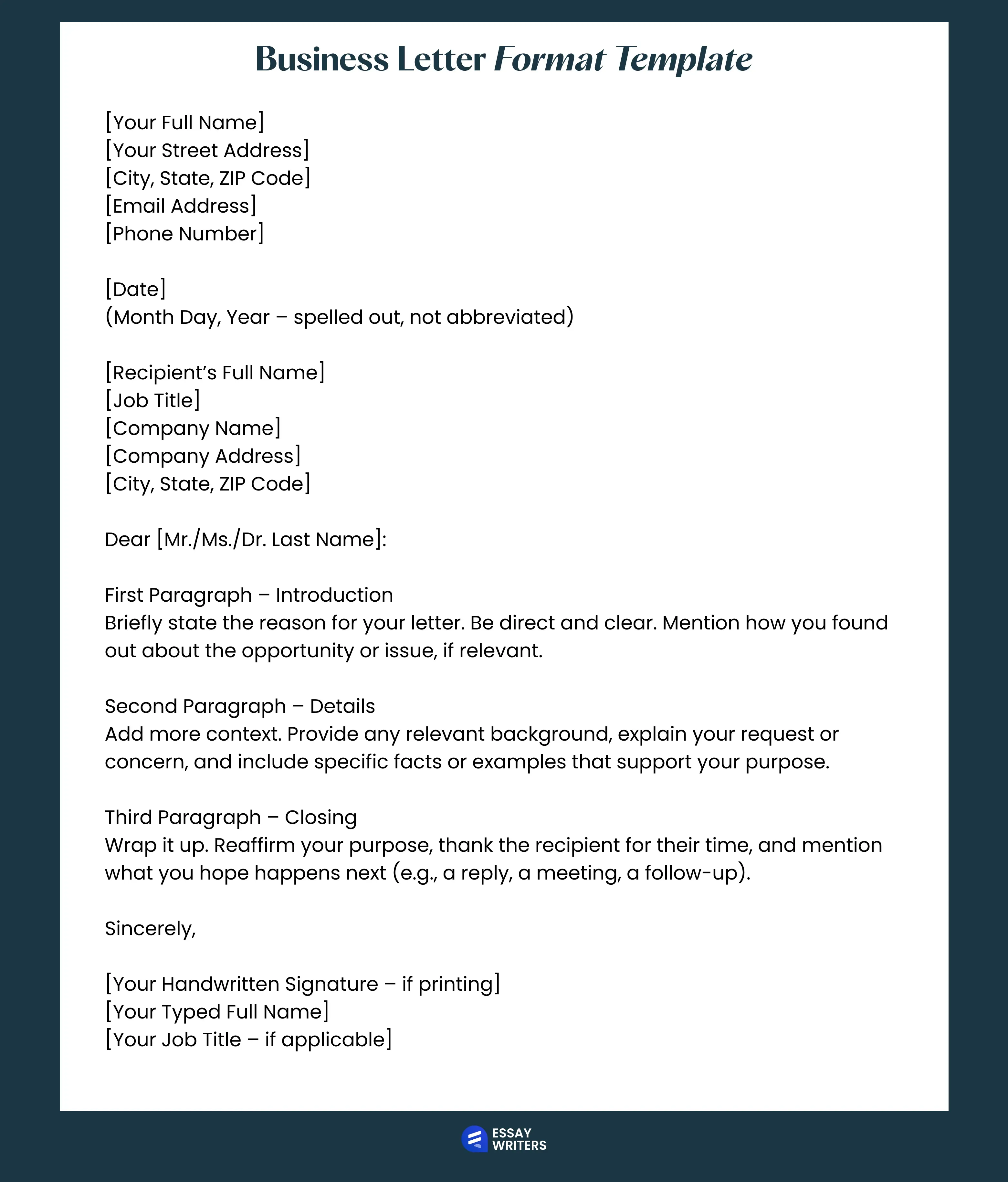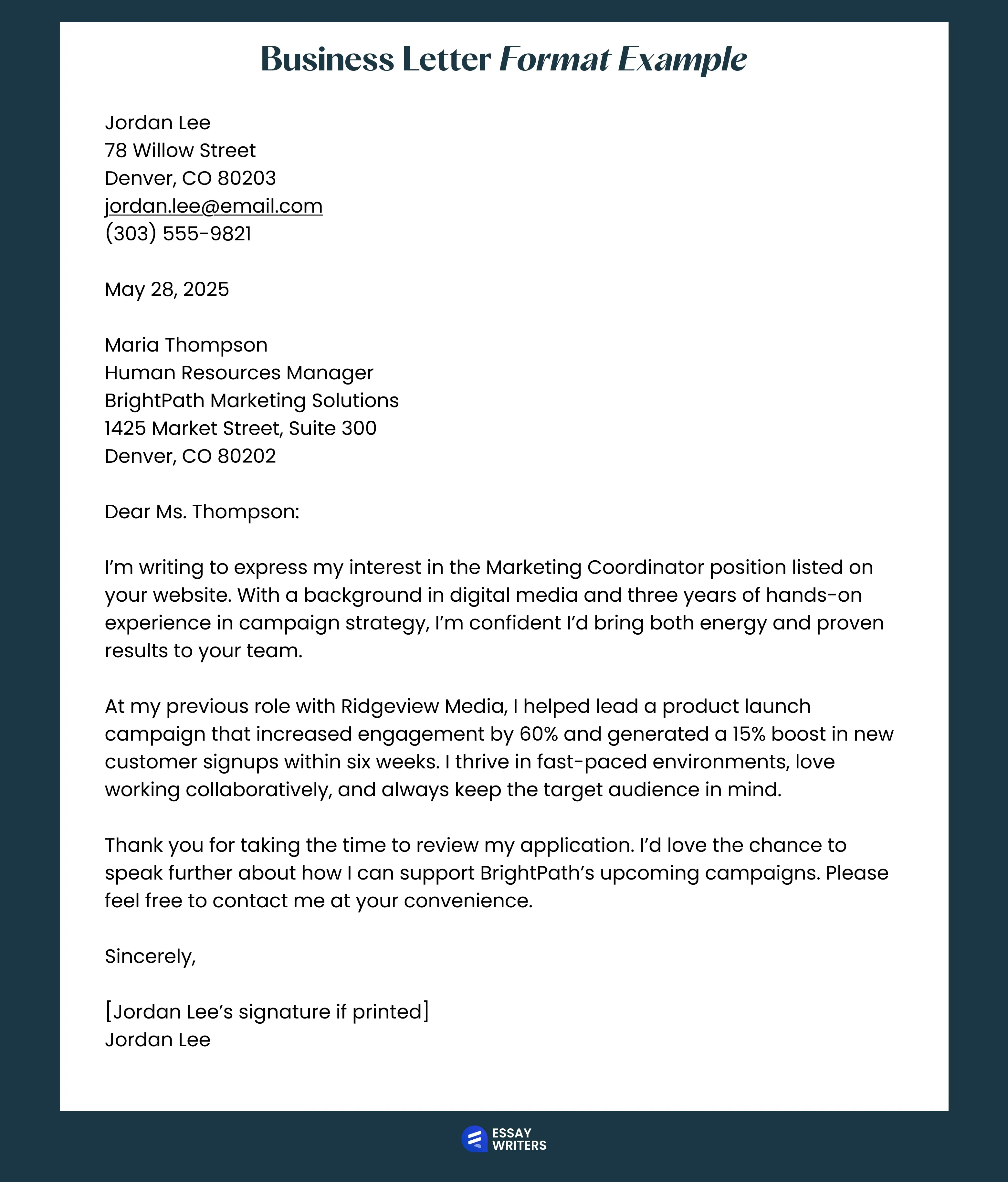
How to write
Business Letter Format: Components, Template, and Example
Author: Michael Perkins
Updated: Aug 3, 2025
min
Table of contents
A business letter is a formal document that’s used to communicate in professional settings. It’s used by both individuals and organizations for job applications, formal notices, or any other types of structured communication. The business letter format is what gives it that polished feel. Each part has its own job and when everything is in its right place, the letter does exactly what it’s supposed to do. Here’s what every standard business letter includes:
- Sender’s address
- Date
- Recipient’s name and address
- Greeting
- Opening line
- Body paragraphs
- Closing line
- Complimentary close
- Signature
If you’re working on a format of the business letter for a class, getting it right can make a real difference. That’s where our best essay writers can step in. Doesn’t matter if you need help with starting the draft or polishing the final version, our platform can get students the support they need with their academic tasks!
Business Letter Components
Formatting your letters properly is a way to keep things clear and respectful.
Every business letter follows a pretty standard structure. Here’s what a sample business letter format usually includes:
- Your address
- The date
- The name of the person you’re writing to
- Their address
- A greeting (yes, the ‘Dear...’ part)
- The main message
- A sign-off
- Your name and signature
Sender’s Address
This goes right at the top before anything else. Just the basics: street, city, state, and ZIP code. If you’re using company letterhead, you can skip it since it’s already printed. But if it’s just you writing on a blank page, this tells the person where they can reach you if needed. No need to include your name here, that’ll come at the end.
Date
Leave a space after your address, then write out the full date, something like ‘May 28, 2025.’ Don’t use numbers or slashes. Spelling it out keeps things clear, especially if the person reading your letter is in another country where date formats vary. It also gives your business format letter a proper timestamp, which can come in handy if timing matters for what you’re writing about.
Recipient’s Name
Write the full name of the person you’re writing to a couple of lines below the date. Mention their title too, like Dr., Mr., Ms., etc, and their role as well if you know it. Something like ‘Mr. Daniel Park, Sales Manager’ works perfectly. Try to find their name if you’re not sure of it, since it always looks better when you address a real person.
Recipient’s Address
Then comes the recipient’s mailing address. Start with a company name (if there is one), list the street address, city, state, and ZIP code. Keep it all aligned to the left margin.
Salutation
The salutation should be simple and respectful. ‘Dear Ms. Rivera:’ or ‘Dear Dr. Lin:’ both work well. And if you don’t know the exact date, instead of the generic ‘To Whom It May Concern,’ try something like ‘Dear Hiring Manager:’ And yes, always end this line with a colon, not a comma.
Body of the Letter
This is where you say what you came to say. Start by getting straight to the point and saying why you are writing. Then explain anything the reader needs to know. Wrap it up with a short closing that makes it clear what you’d like to happen next. Use short paragraphs and keep things polite but direct. Three or four short paragraphs are plenty.
Closing
This part’s simple but still matters. Pick a polite closing, like ‘Sincerely,’ or ‘Best regards,’ capitalize the first word, and don’t forget the comma. After that, leave a few blank lines before typing your name. If you’re printing the letter, that space is where you’ll sign.
Signature
Add your signature in the blank space after signing off. If you’re printing it, sign the letter with black or blue ink. For digital letters, you can simply type your name, but you can also add a scanned version of your signature. Finalize with your job title if it makes sense, and that’s it, you’re done.
Business Letter Formats
You wouldn’t show up to a job interview in gym clothes, right? Writing a business letter works the same way, and how you present it depends on where it’s going and who’s reading it. The format sets the tone before they even get to your first sentence. Most won’t consciously say, ‘Ah yes, full block format,' but they’ll feel the difference between polished and careless.
Different situations call for different looks. And in a world where people skim everything, including emails and resumes, you want to make sure what you send out actually sticks.
Here are the three main formats:
- Full block format
- Modified block format
- Memo format
Full Block Format
Picture a formal business letter format that stands at attention. Every line starts at the left margin, including your address, the date, the greeting, and every single paragraph. It’s straight-up no-nonsense. This is the format that says, I mean business. You’ve probably seen it in formal job applications, cover letters, and complaint letters, where being taken seriously is the goal. And if you're working on a class assignment or report, our business essay writing service can help you apply this format with clarity and confidence.
If you’re not sure which format to use, our essay writers recommend this one as it’s the safest bet and the most confident.
Modified Block Format
Now imagine that same letter but with just enough of a shift to feel more human. That’s a modified block. Your return address, the date, and your sign-off lean to the right side of the page.
This standard business letter format is great when you’re still being formal, but not stiff. Maybe you're writing to someone you've met before, or it's your third follow-up, and you're trying not to sound robotic. Either way, the modified block walks that fine line between structure and personality.
Memo Format
And then there’s the memo, possibly the most misunderstood piece of office writing. It doesn’t try to look pretty. No ‘Dear So-and-So,’ no fancy sign-offs. Just To, From, Date, Subject, and then the message.
This is the format for when you’ve got something important to say and everyone’s already halfway to burnout. Memos are built for speed. Here’s what’s funny: some of the best writing happens in memos. Honest, clear, and fast.
How to Format a Business Letter?
Formatting a business letter says a lot before your reader even starts reading. A sloppy layout makes you look unprepared. A polished one does half the talking for you.
Here’s what to do when formatting a business letter:
- Choose a font that’s easy to read
- Include all the essential sections
- Keep spacing clean and margins even
- Open and sign off with purpose
Use a Font That Doesn’t Distract
Fonts have personalities. Some are calm and confident. Others yell at you for no reason. For a proper business letter format, you want the first kind.
Stick with fonts that people trust, like:
- Times New Roman
- Arial
- Calibri
- Georgia
- Helvetica
Set it to 10 or 12 point size. That’s it. No bold headers, no colors, no creative flairs.
Include All Necessary Information
Every business letter follows a rhythm. Leave something out, and it feels off, even if the reader can’t quite say why. You’re telling a story, and every piece helps it make sense.
Here’s what you always want to include:
- Your address (unless it’s on letterhead)
- The date
- Who you’re writing to, and where they work
- A greeting (yes, a proper one)
- Your message, broken into short, clear paragraphs
- A closing line
- Your name and signature
Don’t Let Bad Spacing Ruin a Good Letter
You can write the perfect message, but if the page looks cluttered, cramped, or off-balance, people might never read it. Spacing is how you allow the format of a business letter to breathe. Without it, your words suffocate.
Give each section a little room. Leave one line between your address and the date, the date and the recipient, and so on. Keep paragraphs single spaced, but don’t let them run into each other. And always use one-inch margins on all four sides.
Start With Intention, End With Confidence
The opening and closing of your letter are the parts people remember. So make them count. Your greeting should be respectful, clear, and ideally addressed to someone by name, like ‘Dear Mr. Rivera:’ or ‘Dear Dr. Owens:’. If you truly don’t know who’s on the other end, something like ‘Dear Hiring Manager:’ works.
When it’s time to sign off, be direct and professional. Good options are:
- Sincerely,
- Best regards,
- Respectfully,
Then leave space to sign your name.
Business Letter Format Template
If you're more of a visual learner, here's a simple business letter format template that shows where each part belongs.

Business Letter Format Example
Below is a real-world business letter format example so that you can see exactly how the tone, structure, and format work together on the page.

Final Thoughts
You don’t have to overthink the professional business letter format, but doing it right will definitely pay off. The way your letter looks can be just as important as what it says. Here’s what to remember:
- Keep your layout easy to follow
- Use a font that’s professional, not distracting
- Follow standard spacing and margin rules
- Include every key section
- Choose the format that fits your tone and purpose
If writing formal letters still feels like a stretch, you’re not alone. Our professional essay writers help students with all kinds of academic and professional writing. We’re here when you need structure, editing, or a second set of eyes — or even business ideas for students who want to turn writing skills into something more.
FAQs
What is Business Letter Format?
Business letter format is the standard way to lay out a formal letter: your info at the top, a greeting, the message, and a polite sign-off. Simple, clean, and easy to follow.
What Does a Business Letter Look Like?
A business letter should look neat and professional. Left-aligned text, short, clear paragraphs, and no weird fonts. Everything must be in its place, so the letter reads smoothly.
How to address business letter in a professional way?
Use the recipient’s full name, job title, company, and address. Many writers follow a simple structure: recipient details at the top, a clear salutation, and a polite opening line.
Where can I find a formal business letter template?
Use our ready-made layouts or build your own by using a simple grid: sender details, date, recipient block, greeting, body, closing, and signature.
How do business letter templates help with structure and tone?
Business letter templates give writers a predictable framework. You can open the file and focus on your message instead of formatting choices. This helps students, interns, and new professionals create polished letters that follow workplace standards.
What is the correct business letter format for everyday professional communication?
The correct business letter format usually follows a left-aligned structure with single spacing and clear section order. The letter begins with contact details, moves into the greeting, and then delivers a focused message in short paragraphs. The closing and signature complete the layout.
Sources
Northern Michigan University. (n.d.). Parts of a business letter. NMU Writing Center. https://nmu.edu/writingcenter/parts-business-letter


